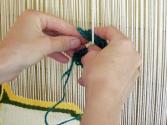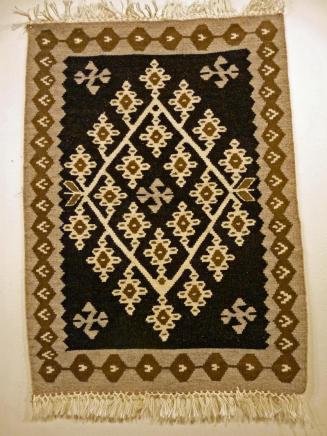Bosnian Ćilim (Carpet) by Fikreta Muratovic
SubjectPortrait of
Fikreta Muratovic
(Bosnian)
Date2010 June 18
Mediumborn digital photography
ClassificationsGraphics
Credit LineConnecticut Cultural Heritage Arts Program collections
CopyrightIn Copyright
Object number2015.196.741.1-.9
DescriptionPhotographs of a large woven ćilim (carpet) made by Fikreta Muratovic in her home in Hartford. This ćilim is 9 feet by 12 feet, woven with cotton/linen warp and wool weft. Fikreta made this exactly like one she had woven in Bosnia when she worked with Bosfam, a cultural organization that employed weavers as a way to market ćilimi, support women artists, and maintain traditional weaving after the war. The large loom needed for this ćilim was made by her father, Bajro Vejzovic. The rug was displayed in the "Rugs of Remembrance: Bosnian Weaving in Hartford" exhibition. This ćilim is in the collection of the Connecticut Museum of Culture and History, 2015.228.18
(.1) Image of a detail view of the large woven carpet made by Fikreta Muratovic.
(.2-.6) Images of Fikreta Muratovic weaving the carpet on the loom in her home.
(.7) Image of a page from the Bosfam catalogue of Bosnian weavings made in Bosnia showing the original ćilim made by Fikreta Muratovic in Bosnia.
(.8) Image of Fikreta Muratovic weaving the carpet on the loom in her home.
(.9) Image of a vegetable "burek", a Bosnian dish, made by Fikreta Muratovic during the CCHAP visit to document the rug weaving.
NotesBiographical Note: Fikreta Muratovic, Fatima Vejzovic's daughter, is a talented weaver in her own right, who learned this art from her mother and also while working at the Bosfam collective in Sarajevo. She created a new 9 x 12 foot carpet in 2011 that was a replica of one she had woven in Bosnia.(.1) Image of a detail view of the large woven carpet made by Fikreta Muratovic.
(.2-.6) Images of Fikreta Muratovic weaving the carpet on the loom in her home.
(.7) Image of a page from the Bosfam catalogue of Bosnian weavings made in Bosnia showing the original ćilim made by Fikreta Muratovic in Bosnia.
(.8) Image of Fikreta Muratovic weaving the carpet on the loom in her home.
(.9) Image of a vegetable "burek", a Bosnian dish, made by Fikreta Muratovic during the CCHAP visit to document the rug weaving.
Subject Note: The Institute for Community Research (ICR) hosted the exhibition, "Rugs of Remembrance: Bosnian Weaving in Hartford," from November 3, 2011 to May 31, 2012, in the Jean J. Schensul Community Gallery at 2 Hartford Square West, 146 Wyllys St., in Hartford. The exhibit displayed hand woven rugs, carpets, and wall hangings made by skilled Bosnian weavers living in Hartford. A special memorial quilt from Bosnia was also on view, loaned by the social justice organization Advocacy Net. The opening event featured weaving demonstrations as well as Bosnian music and food.
Greater Hartford is now home to several thousand Bosnians, many coming here as refugees from the war in the former Yugoslavia in the late 1990s and early 2000s. For the many widows in the community, continuing to practice their familiar arts of weaving, knitting, and crochet lace helps them to cope with the trauma of the genocide their families suffered. With the Bosnian community having a vibrant presence in Hartford, the exhibit provided a chance for audiences to meet these talented artists, learn more about Bosnian culture, and watch them weaving at their looms. The project created new opportunities for the weavers to teach others about their traditions, something they love to do.
Since 2007, ICR’s Connecticut Cultural Heritage Arts Program (CCHAP, now based at the Connecticut Historical Society) has worked with Bosnian artists to encourage production and marketing of their exquisite carpets, called ćilimi. CCHAP’s Sewing Circle project with newcomer textile artists in Greater Hartford has helped to improve English skills, involve the weavers in American society, and support their families. Some of the experienced weavers have been teaching young women in the community to weave, helping to pass on the tradition in their new home.
The exhibit displayed carpets and wall hangings made by five Bosnian weavers who have participated in the Sewing Circle Project. The weavers have been highly successful in continuing to produce and market their traditional weavings and selling them at craft fairs, farmers markets, and special events. Through a special partnership with Clatter Ridge Farm, whose sheep graze on the grounds of the Hill-Stead Museum in Farmington, Connecticut, the Bosnian weavers used their high-quality Shetland wool to create several new weavings that were on display in the exhibit. The natural colors and soft yet strong texture of the resulting carpets equal the quality of Navajo rugs. Several of these carpets were sold during the exhibit, with all profits going to the weavers. The weavers also made two new works, one a 12 x 9 foot carpet, and the other a “quilt” made up of squares woven by six different women with the names of their towns. The beginner weavers who participated in this group piece learned from the experienced weavers how to do this, helping to preserve the art form.
Also displayed in the exhibit was a large memorial quilt made by weavers in Bosnia who helped their own healing process (after the genocide of the 1990s) by weaving squares with the names of their relatives who had died during the war. CCHAP partnered with Advocacy Net, a DC-based non-profit that has worked with weavers in Bosnia after the war, to bring in the traveling quilt, which the Hartford weavers repaired with great care. This large-scale quilt was the centerpiece of the exhibit, a focal point for giving audiences some background information on the history of these newcomers.
The exhibit was supported by the Aurora Women and Girls Foundation and the Greater Hartford Arts Council through contributors to its United Arts Campaign and the United Way Community Campaign. CCHAP’s participation was funded by the National Endowment for the Arts, the Connecticut Commission on Culture and Tourism, and the Institute for Community Research.
Additional photographic and video materials are present in the CCHAP archive relating to this event, this community, and the artists.
Cataloging Note: This project was made possible in part by the Institute of Museum and Library Services MA-245929-OMS-20.
Status
Not on viewFatima Vejzovic
2011 November 16
Fikreta Muratovic
2011 October 21
Haris Gusta Guya
2011 November 4
Fatima Vejzovic
2015 March 14






















